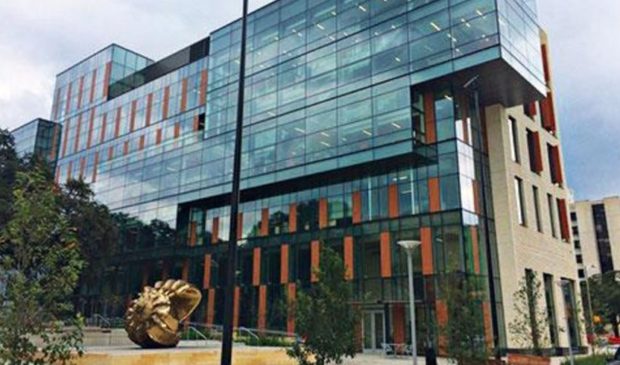Medical school outlines spending, outreach for care in eastern ‘Austin crescent’
Tuesday, January 31, 2017 by
Chad Swiatecki With Travis County putting more scrutiny on one of the Dell Medical School at the University of Texas’ largest financial contributors – specifically Central Health and the $35 million in taxpayer dollars it provides the school annually – leaders of the still-new school issued an in-person community progress report on Monday that focused on its initial successes.
The session at the Austin Public Library’s Carver Branch in East Austin was held to drive home the school’s mission to help provide comprehensive medical care to the city’s poor and underserved populations. Those communities tend to be concentrated in the area known as Austin’s “eastern crescent,” which is based in East Austin and stretches north to Rundberg Lane and to the southwest.
Clay Johnston, who in January began his third year as dean of the medical school, opened the meeting going heavy on numbers. Johnston said the Central Health funding has been mostly saved to cover indigent care costs once the school is fully up and running, with $5.7 million spent on care costs in Fiscal Year 2014-15, $23.1 million in FY 2015-16 and $52 million budgeted for the current fiscal year.
While not addressing the criticism from community watchdogs who claim that Central Health money has been put toward noncare costs, Johnston stressed that only money from the state has been used to pay for construction, academic operations or any preliminary work on the redevelopment of the University Medical Center Brackenridge property that is almost entirely owned by Central Health.
The school’s current fiscal year budget is $105 million, with other money coming from research grants, commercial operations, tuition, philanthropy and the UT system. Johnston also said the school has nearly completed its assembly of the financial records it will submit to Central Health in February as part of the agency’s review process.
As examples of the school’s early success, Johnston pointed to outreach for orthopedic surgery patients in East Austin that cut wait times that had routinely stretched to 14 months down to less than one month, and cut the cost of that care by one-third.
He also said the school’s department of psychiatry is in the early stages of working with Central Health, Austin Travis County Integral Care, local prisons, hospitals and the state to create an area-wide plan for improving mental health services.
“If we’re talking about making Austin a model health city, the best thing we can do is improve the health of our people and do what we can to overcome inequities,” Johnston said. “Some of those are around social determinants of health. Part of that is patching people up when they hit the emergency room but also working to keep them healthy, and invest(ing) savings in health care dollars back into those environments.”
Addressing the school’s outreach efforts were Bill Tierney, chair of population health, and Lourdes Rodríguez, director of the school’s Center for Place-Based Initiatives. Rodríguez touted the response from a new twice-yearly initiative to gather ideas from the public about ways to improve community health, with the most promising submissions eligible for research and funding efforts.
Tierney, who spent more than a decade researching and combating AIDS and HIV in Kenya, said the school is focusing on gathering data about the needs of the 200,000 economically distressed residents who make up the heart of Central Health’s patient base.
The most aggressive of those efforts will seek a team being formed by Tierney to visit more than 300,000 households throughout East Austin to get information on health care and other needs in 22 distinct subcommunities whose health, economic and social needs often intermingle to limit their social mobility. Tierney is also at work on creating a local health information exchange with data from the area’s hospital systems to create better medical histories on patients in the Central Health safety net and improve the care they receive.
After the session, Johnston said the school and its stakeholders are still evaluating how the anticipated repeal of the Affordable Care Act would affect the school, but he said local residents who purchased health insurance through the federal exchange could overburden the local network if they turn to area agencies for care due to a loss of coverage.
Johnston also said Capital City Innovation – the nonprofit created in 2016 to help coordinate business interests related to research at the school – is nearing the end of its search for its first executive director, with announcements of business recruitment and redevelopment efforts around the school likely to pick up by the middle of this year.
Image courtesy of Dell Medical School.
The Austin Monitor’s work is made possible by donations from the community. Though our reporting covers donors from time to time, we are careful to keep business and editorial efforts separate while maintaining transparency. A complete list of donors is available here, and our code of ethics is explained here.
You're a community leader
And we’re honored you look to us for serious, in-depth news. You know a strong community needs local and dedicated watchdog reporting. We’re here for you and that won’t change. Now will you take the powerful next step and support our nonprofit news organization?









